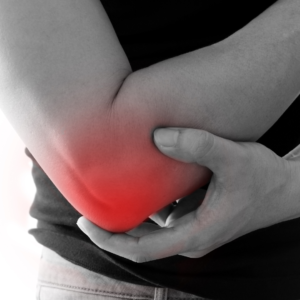Tennis elbow, also known as lateral epicondylitis, is a common condition that primarily affects the muscles and tendons of the forearm, leading to pain and discomfort in the outer elbow.
This condition is caused by repetitive arm and wrist activities, including, but not limited to tennis. So, despite the name, you don’t need to play tennis to have this injury.
In this article, we will discuss what tennis elbow is, the muscles involved, and exercises to help treat it.
Causes and Affected Muscles

Tennis elbow is typically linked to overuse and muscle strain.
The primary muscle involved is the extensor carpi radialis brevis (ECRB).
This muscle helps stabilize the wrist when the elbow is straight, such as during a tennis stroke.
Overuse leads to microscopic tears in the tendon where it attaches to the lateral epicondyle (outside) of the elbow, causing inflammation and pain.
While named after tennis, the condition can arise from various activities involving repetitive wrist and arm movements, such as painting, plumbing, and extensive computer mouse use 1,2,3.
Impact on Older Adults

Older adults may be particularly susceptible to tennis elbow if they frequently do repetitive movements at the forearm. As with all parts of the body, we frequently are unaware if we’re overusing one muscle/muscle group compared to another until we start to feel pain.
So it’s important that when we notice the pain, we don’t try to push past it, but rather, we want to address it with exercises so we don’t get to a point where the pain is keeping us from doing what we love.
Additionally, as we age, our body’s healing processes slow down, potentially prolonging recovery from repetitive strain injuries.
It’s important for older individuals to be aware of the activities that can exacerbate this condition and to take preventive measures when engaging in repetitive arm movements1. This includes making sure we have the strength and body awareness to properly engage the right muscles for the job.
5 Exercises for Treatment of Tennis Elbow
Click HERE for a video of Dr. Katie Landier, PT, DPT completing these exercises
1. Wrist Extension Stretch:
- Extend your arm in front of you with your palm facing down.
- Gently bend your wrist downwards using your other hand.
- Hold this position for 30 seconds to 1 minute, then relax.
- Repeat 2 to 4 times.
2. Wrist Flexion Stretch:
- Extend your arm with your palm facing up.
- Gently bend your wrist upwards, using your other hand to pull the fingers back towards your body.
- Hold for 30 seconds to 1 minute
- Repeat 2 to 4 times.
3. Wrist Extensor Strengthening
- Rest your forearm on a table with your hand hanging over the edge, palm down.
- Hold a light weight (like a small dumbbell or a can of soup) and slowly lift your hand up and down at the wrist.
- Complete 15 repetitions.
- Take a 1-3 minute rest.
- Complete 3 sets.
4. Towel Twist
- Hold a rolled hand towel with both hands, shoulder-width apart.
- Twist the towel by moving your hands in opposite directions as if you are wringing out water.
- Do this action in both directions 10 times each.
- Rest for 1 minute.
- Complete 3 sets.
5. Finger Stretch
- Place your hand flat on a table, palm down.
- Gently spread your fingers apart as far as comfortable and hold for 5-10 seconds.
- Release and repeat 8-10 times.
It’s important to perform these exercises gently and to stop if you experience pain. Additionally, consulting with a physical therapist for personalized guidance is highly recommended, especially for older adults who may have specific physical considerations.
In Summary
Understanding the causes and impacts of tennis elbow, particularly in older adults, is helpful for alleviating pain and restoring function.
Incorporating specific exercises into a daily routine can be beneficial in managing symptoms and improving overall arm function.
Remember, it’s always advisable to consult with a healthcare professional before starting any new exercise regimen.
Have the Strength to Live Life to the Fullest!
Please Remember to Subscribe and Check out our YouTube Channel!
Sources:
- Mayo Clinic Staff. (2023, September 7). Tennis elbow – Symptoms and causes. Mayo Clinic. Retrieved from https://www.mayoclinic.org/diseases-conditions/tennis-elbow/symptoms-causes/syc-20351987
- Cleveland Clinic. (n.d.). Tennis Elbow: What it is, Causes, Symptoms & Treatment. Cleveland Clinic. Retrieved from https://my.clevelandclinic.org/health/diseases/7049-tennis-elbow-lateral-epicondylitis
- American Academy of Orthopaedic Surgeons. (n.d.). Tennis Elbow (Lateral Epicondylitis). OrthoInfo. Retrieved from https://orthoinfo.aaos.org/en/diseases–conditions/tennis-elbow-lateral-epicondylitis



